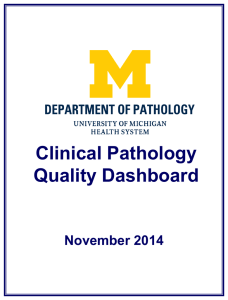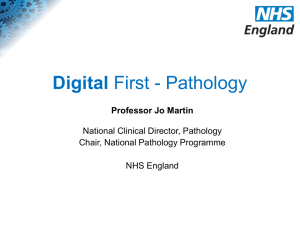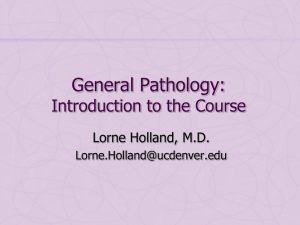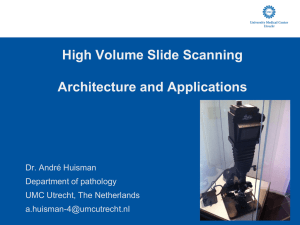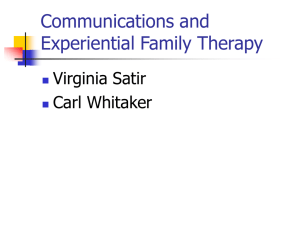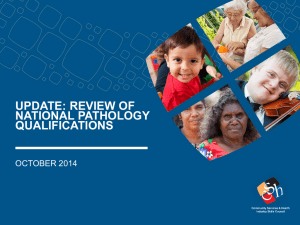October - Pathology - University of Michigan
advertisement
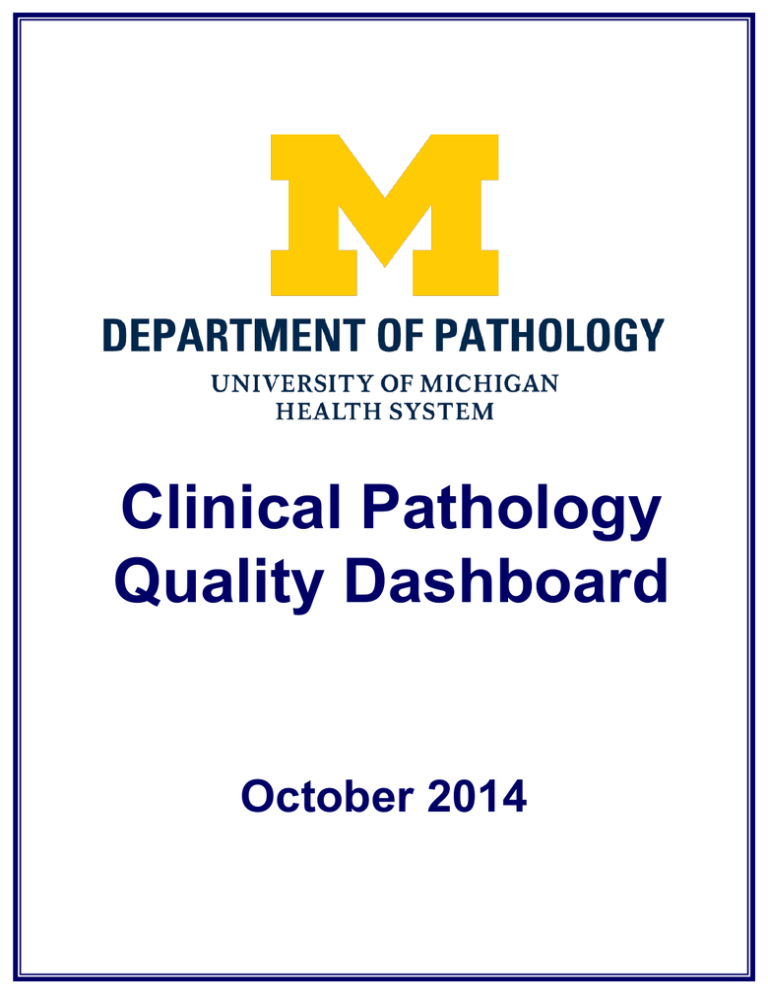
Clinical Pathology Quality Dashboard October 2014 Clinical Pathology Patient Care Quality Pathology-Blood Drive • • • • • • We have not been able to meet our goal despite numerous endeavors to create incentives for donors. We’ve also teamed up with Wolverines for Life for donor recruitment and Blood Battle events. Typically there are ~ 10 presenting donors per drive that are deferred either due to their current health status or answers on the donor questionnaire. We’ve consistently had a large number of no shows that hovers around 25% per drive. Several investigations with direct communication to donors indicated people either forgot despite reminders from ARC, or were too busy to come to the appointment. In response to donor need we have moved the start time starting in August 2014 from 7am to 6am so more staff could donate before the day shift began or during midnight-day overlaps. Blood drives are typically held monthly and can range from 1-2 days. There are numerous other drives held throughout the University of Michigan campus. Donors can find upcoming drives by going to wwww.redcrossblood.org and searching under the Sponsor Code=goblue Clinical Pathology Patient Care Quality Blood Bank Pathology is pursuing a two pronged approach to “specimen quality” in the Emergency Department (ED). 1. There are and have been ongoing discussions via Nursing Liaisons (Barb Wetula, RN, and Sheryl Woloskie) to address training for non-Pathology collected specimens. This focus has been throughout UMHS, with an emphasis on the ED. 2. Pathology and the ED are investigating possible deployment of additional Pathology personal in the ED POCT lab or utilization of the Soft ID system which has been shown to decrease patient identification/signature errors at other institutions. 3. We continue to see a decrease in many of the problems for the 3rd quarter of this year. Problems that have not decreased have at least been maintained compared to past quarters. There has been extra effort into refining training as well as processes. We will continue to monitor this metric for sustainability. Clinical Pathology Patient Care Quality Chemistry Description of Problem: The guaiac method for detecting blood in the stool as a detection of colorectal cancer requires the patient to adhere to several dietary restrictions as well as to collect three separate stool samples. Due to this complexity, we had low compliance (<20%). Newer methodologies such as FIT are available that only require a single sample, no dietary restrictions, and have a higher sensitivity. Impact of Problem: Formerly, the guaiac cards we distributed had a low rate of return as indicated above. Use of the newer immunochemical method has increased the rate of return almost four-fold due to ease of collection by the patient. Reporter of Problem: Laboratories, physician offices Description of Solution: Implement the immunochemical method for detection of colorectal cancer. Physicians would order the test when the kit was handed to the patient. Pre-stamped envelopes provided to the patient will be returned to the laboratory where the test will be run. How we know it worked: We continue to see a positive outcome relative to patient compliance with returning the kit for testing. For the past 6 months we’ve seen a 1-2% increase each month. Since November 2013 we have increased compliance by 40%. Issues related to the date of order, release & collection are being investigated by MiChart & Chemistry. Date Solution Implemented: October 29, 2013 Clinical Pathology Patient Care Quality Hematology Description of Problem: The Hematology lab created specific parameters related to the complete blood count (CBC) that reflex to the pathologist for a review starting in 2005. Impact of Problem: Inappropriate requests increase cost due to the additional pathologist review (pathrev) and impair the turnaround time for patients that require a pathologist review since there is no way to prioritize these if all of the slides are reviewed. Reporter of Problem: Hematology Pathologists/Staff Description of Solution: Alter the current policy based on medical director guidance to allow specially trained, competency assessed technologists to prescreen path-rev slides. If screens are determined to be inappropriate for pathologist review the path-rev would be canceled. How we know it worked? Over 40% of all path-rev orders requests received each month are canceled thus improving turnaround time and decreasing the cost to the institution and patient. Technologist decisions are assessed monthly. Approximately, 10 cases per month are reviewed rotated between 5 screener technologists. This equates to each technologist being assessed twice per year. Areas for continued improvement: The Hematology lab is in the process of reviewing the criteria set to reflex the path-rev to determine which criteria require a pathologist intervention versus review by qualified technologists. Clinical Pathology Patient Care Quality Hematology Description of Problem: Historically, MD requests have been processed as ordered. During the past year, there has been an upward trend in the number of Pathology Review requests from providers. Investigation into why this is occurring and whether the requests are appropriate and could be triaged in other ways is in progress. Impact of Problem: If requests are inappropriate this results in the unneeded cost of Pathologist review and delays turnaround time for patients that should require a pathologist to review their slide. Reporter of Problem: Hematology Pathologists/Staff Description of Solution: Alter the current policy and allow technologists to prescreen MD request slides similarly to the Path-rev process used for CBCs. This is done after after an initial audit by a pathologist review of cases deemed not to require MD Path Review assures patient safety. If screens are determined to be inappropriate the MD Path Review would be canceled by the technologist. How we know it worked? TBD-Plans for implementation are ongoing. Late 2014 is the anticipated target date for implementation. Areas for continued improvement: Hematology will be investigating reasons why orders are received in error to providers (e.g. standing orders, errant orders, or improper understanding of the order code). Clinical Pathology Patient Care Quality Microbiology URCC=urine culture UA=urinalysis UC=UA with reflex URCC if UA=positive Root Cause Follow-up Ordering cultures on asymptomatic patients Training for care providers on proper test utilization Collecting specimens from urine catheter bag not the catheter line Training implemented for nursing Delays in transport cause bacterial growth=false positives Use BD urine vacutainers for collections to increase storage time at room temp Triage screening test UC (UA with reflex URCC) not available for inpatients Made UC triage available for inpatients Urine cultures being “over worked” Modify protocols for urine specimens to be consistent with guidelines Description of Problem: Rates of catheter associated urinary tract infections (CAUTI) are a metric benchmark for patient quality of care. The inpatient population is particularly prone to high rates of infection. The CCMU (6D) is a focus of attention due to their patient population and propensity for positive urine cultures. The NHSN (National Healthcare Safety Network) benchmark is 2.9 infections per 1000 catheter days. In 2013 the CCMU rate was 5.5. While investigating the CCMU, it was discovered that the rate was falsely elevated due to a large number of false positive cultures (>80 % non-pathogen yeast with 20% of these indicating a negative urinalysis). Areas for continued improvement: 1. Impact of Problem: Clinically irrelevant positive urine cultures can lead to additional testing and antibiotics, both of which may be unnecessary. Inefficient use of resources to process these specimens is also a concern. Reporter of Problem: CCMU, Microbiology leadership & Infection Control Description of Solution: Several countermeasures are being implemented or addressed. 2. 3. Data pertaining to the use of the UC and UA/URCC orders indicates that re-education regarding use of the test codes is warranted. This is being facilitated by Infection Control. Continue to revise Microbiology protocol for culture work-up The CCMU CAUTI rate has dropped to 4.5 since countermeasures have been implemented, however rates need to meet the NHSN benchmark of 2.9. Clinical Pathology Patient Care Quality Point of Care *Note Aug 2013 data decreased due to POC coordinator absence and RMPRO reports not entered during this time frame. * Description of Problem: Once MiChart was implemented, a change occurred in how the patient was identified. In order to correlate billing information relative to the specific patient stay, the CSN number on the patient’s wristband is used rather than the MRN. The patient’s wristband was changed so that the glucometer CSN number is now a 1D barcode versus the MRN which is a 2D barcode. Since making this change, numerous errors have occurred where the MRN was manually entered by mistake into the RAALS laboratory middleware. The RAALS middleware requires the current CSN to function properly. Impact of Problem: The errors cause a delay in results being reported to the patient record. Additionally, the corrective action is for the POC Coordinator to match the misidentified patient results and then manually report them to the correct CSN. This opens the opportunity for human transcription errors along with inefficient use of the coordinator’s time to work on other tasks. Reporter of Problem: POC Coordinator & Nursing Leadership Description of Root Causes Identified: • Nursing is not able to access the barcode and has to manually enter CSN. Manual entry may be incorrect or the MRN (traditionally used for other tasks when identifying patients) may be used. This is especially true of pediatric wristbands which are smaller. Nurse educators have refocused training on this aspect. Investigation into modifying the patient wristband to allow more barcodes to be visible is ongoing by MiChart. • CSN mismatch-Examples of patients presenting at the ER or IPLV (Inpatient Like Venues) and then admitted on a different day (thus different CSN) still have their “old” wristband on which is no longer valid. Wristband printing-future visit day used to print wristband. Practice change by nursing to replace patient wrist band every time patient comes or returns to the floor (e.g. go to OR or procedure area and come back). • Identified reasons why nurses are manually entering MRNs and implementing countermeasures to address delays in downloading patient names & results to the patient’s record. • Modification of the wristband to limit the frequency of manually entered CSNs. • POC coordinators are working with Alere and the interface with the glucometers to identify reasons why patient information does not download to the meter for positive patient ID. BW2 Canton Chelsea DOM DFW FMC EAA Livonia Northville Saline WAA Ypsi Needs attention Progressing Excellent Not Completed Yet N/A BWO BMG Brighton Health Center Safety Audits Clinical Pathology Quality and Performance Safety audits were performed by the Pathology Safety Liaisons between March and September 2014. Each Safety Liaison will work with the section supervisor & Compliance Manager to rectify the “needs attention” areas. Chose another topic to audit replacing ergonomics, Chose another topic to audit replacing ergonomics Chose another topic to audit replacing ergonomics Un i q ue C h Pe em rs ic o a n al l In Pr A v n e o n n t u e to al ct ry ive Sa Bi f E et oh qu yA az ip u m a dit rd en Sp W t li l-K ar ni it ng W Si a gn s te s La b Ac eli cid ng e nt Re St o c r o ag rd e s La b e l in g P C r h ep em ar ic e d a lE Ch St xp a e f m fc o su i ca an r e ls f in U M Ch d on S o i D t os or S in e a Er : g nd go 2 In Ch n o d e m en m ics Sp ti f ica ie e l r cim s Hy be gi en f e o En n re Tr e gi an dr La n a e s b po w e el ir n rt in PP g g E Co W n t ro or n Sp ls Pe ec r i m P oli e n cy Ey Tr ew an a s sh po rt Co & Sh de o S we i l ve rrs Fi rR re e Dr vi e ill w P SD ar ti c S i S p h at ee io ts n R Up ep to or t Da te Blood Bank Chemical Pathology Cytogenetics Cytology Hematology Histology Immunology MiOncoseq Microbiology Molecular Diagnostics Phlebotomy Specimen Processing Needs attention Progressing Excellent Not Completed Yet N/A Laboratory Safety Audits Clinical Pathology Quality and Performance Safety audits were performed by the Pathology Safety Liaisons between March and September 2014. Each Safety Liaison will work with the section supervisor & Compliance Manager to rectify the “needs attention” areas. Un i q ue C h Pe em rs ic o a n al l In Pr An ve o n n t u e to al ct ry ive Sa Bi f E et oh qu yA az ip u m a dit rd en Sp W t i ll-K ar ni it ng W Si a gn s te s La b Ac eli cid ng e nt Re S t or c or ag ds e La be l ing P C r h ep em ar ic e d a lE Ch St xp a e f m fc o su i ca an r e ls f in U M Ch d on S o i D t os or S in e a E g n r go d Ch no e m m ics Sp ica e l c H im yg en ie E n T n e ra gi La ns ne b p e e or rin lin PP t g g E C o W nt or ro n Ex ls Pe po rP s u o re li c E C y y o ew nt ro as l h Pl In & an op Sh e o r ab w er le C rs o Eq m ui pr pm e s se en Fi re d tT G Dr a as gg ill ing P S a D rti S ci p Sh a e t io et n s R U e p po to rt Da te CP QA Meeting Highlight Michigan Molecular Genetics Laboratory (MMGL) Description of Problem: Late December 2013 MMGL contracted with Blue Cross Blue Shield to perform in-state BRCA1 & BRCA2 genetic testing. Mutations of two genes are linked to the risk a woman has of developing breast or ovarian cancer. Men carrying these mutations are at increased risk for breast cancer and for prostate cancer. The methodology used by MMGL at that time could not handle the anticipated increase in workload due to the low number of specimens batched and long analytic time. Impact of Problem: The current methodology would not sustain the anticipated increase in volume. This could result in an increased turnaround time (TAT) that would be unacceptable to patients. Description of Solution: Modify methodology to accommodate the increase in testing volume. How we know it worked: Entire process is less costly and the TAT decreased. In addition, the TAT for other assays also improved due to increased capacity of the Biomek FX that was purchased to help facilitate the improvement process. Date Solution Implemented: January 2014 CP QA Meeting Highlight (cont.) Michigan Molecular Genetics Laboratory (MMGL) Clinical Pathology Quality and Performance Proficiency Testing Performance 2013 The Clinical laboratories are required to test unknown specimens to generate results that are submitted to the College of American Pathologists (CAP). CAP then reviews the results for accuracy. These results are considered pass or fail based on specific cutoffs established by CAP. There may be instances where typographical errors occur which also results in a failure. Frequent failure can result in a laboratory not being able to test the analyte at their facility. The Clinical Laboratories continue to illustrate superb performance relative testing these unknown samples. In the 1 st & 3rd quarter of 2014 we observed a minor decline. In both instances this was due to one laboratory failing to turn in results by the required deadline, thus resulting in a failure. This laboratory is refining their procedure for handling submission of CAP results to avoid this in future challenges. Clinical Pathology-Current Projects **This is a highlight of projects ongoing in the CP labs. This list is not meant to be all inclusive of every activity occurring in the department. Project Brief Description Owner Customer Service/Call Center Address multiple issues related to providing an appropriate level of customer service for UMHS care providers. Dr. Newton ER Specimen Issues In coordination with the Emergency Department reduce the number of RMPRO specimen errors (e.g. hemolysis, mislabels etc.) S. Butch/K. Martin/T. Morrow Pathology Handbook Maintain and update the Pathology handbook to be a robust resource for our customers. K. Davis/K. Martin NCRC Planning Begin work to plan for the future state of the non-STAT Clinical Labs move to NCRC PRR Committee Clinical Laboratory News, Notes, and Kudos -----------------------------------------------------------------------------------•Labs that are working on process improvement projects that would like to display data can contact Kristina Martin (martkris@umich.edu) for future dashboards. Kudos 2014 CP Symposium Planning Committee for planning 2 days of enriching CE opportunities Kelly Anderson Suzanne Butch Kristina Martin Carol Young Linda Brish Suzanne Clark Dr. Newton Denise Brown Eric Jedynak Pam Warwashana Pathology Quality Month Posters 1. Lab Molecular Diagnostics Project Title Molecular Diagnostics Laboratory Process Improvement: Organizing and Tracking Patient Tissue Section Samples Argatroban Monitoring: Anti-IIa Vs aPTT Team Members Michelle Russell, Catherine Dixon, Nanci Lefebvre, and Jennifer Bergendahl 2. Hematology 3. Hematology Auto Receipt of Specimens on a Robotic 4. Hematology PNH: Developing a High Tech Test to Improve Patient Care 5. Pathology Physician InboxEnsuring Results are Routed to the Correct Provider 6. Histology Explants in Pathology Lisa Taulbee, Histology Lab Manager Meagan Weighman, Senior Histotechnologist Nancy Fritzemeier, Pathology Office Manager Christine Rigney, Assistant Administrator, AP Operations John Perrin, QC Bill Lalonde, Tissue Specimen Coordinator Debbie Woodard, Lab Assistant 7. Consult Accessioning Pathology Transfer Christine Rigney, Sara Gay MT(ASCP), Steven W. Pipe, MD, Ngoc Vu, Pharm D, Cesar Alaniz, PharmD Gerald (Jerry) Davis, MT(ASCP) MPH, Usha Kota, MT(ASCP), Mary Jane Liu MT(ASCP), Megan Lim, MD PhD, heme staff, SCC Laura (Laurie) Gable, MT(ASCP), Usha Kota, MT(ASCP), Lloyd M. Stoolman, MD, Flow Cytometry lab staff Brian Kurtz, Elizabeth Renner (AntiCoagulation Service), Sam Coffey, Cybill Rowerdink, Adam Schneider (MCIT), Kathy Davis, Chris Gaunt, Bill Hubbard, Kristina Martin, Harry Neusius (Pathology) Pathology Quality Month Posters 7. Lab Consult Accessioning Project Title Pathology Transfer Case Material Returns Team Members Christine Rigney, Assistant Administrator, AP Operations Nancy Fritzemeier, Office Manager Shirley Andrews, Lead Pathology Admin Consult Accessioning Team: Sheri Welton, Alex Short, Lorraine Bourassa, Therese Nickerson, Tammi Toth 8. Chemistry Decreasing ED Stroke Prothrombin Turnaround Times 9. Immunology Implementation of a New Ordering System in the Immunology Lab Ch-Ch- Changes! Moving to a 10 hour shift to reduce overtime Quick & Easy Chemistry Test Results Sample Manager Switch leads to TAT Satisfaction Catheter Associated Urinary Tract Infections (CAUTI), not the “yeast” of our concerns John Alfsen, Don Giacherio, David Harro, Chemistry ED Laboratory Technicians Donna Bush 10. Immunology 11. Chemistry 12. Microbiology 13. Histocompatibility HLA Lab Software System Saves Money, Improves Efficiency & reduces TAT Chris Offord Eric VasBinder, Therese Horning and Ruth Miller Noel Baldwin, RN Jennifer Dammeyer, RN, MSN Sam Miller, RN Duane Newton, Ph.D., D(ABMM) Laraine Washer, MD Amanda Valyko, MPH, CIC Lena Kleyman Thomas Franks Saburo Shelton Thomas Peterson Debra Schauss Mia Kost Jagadish Chaparala Judy Knakiewicz Gregory Simmons Judy Wysocki Yusuf Peak Caitlin Parsons
